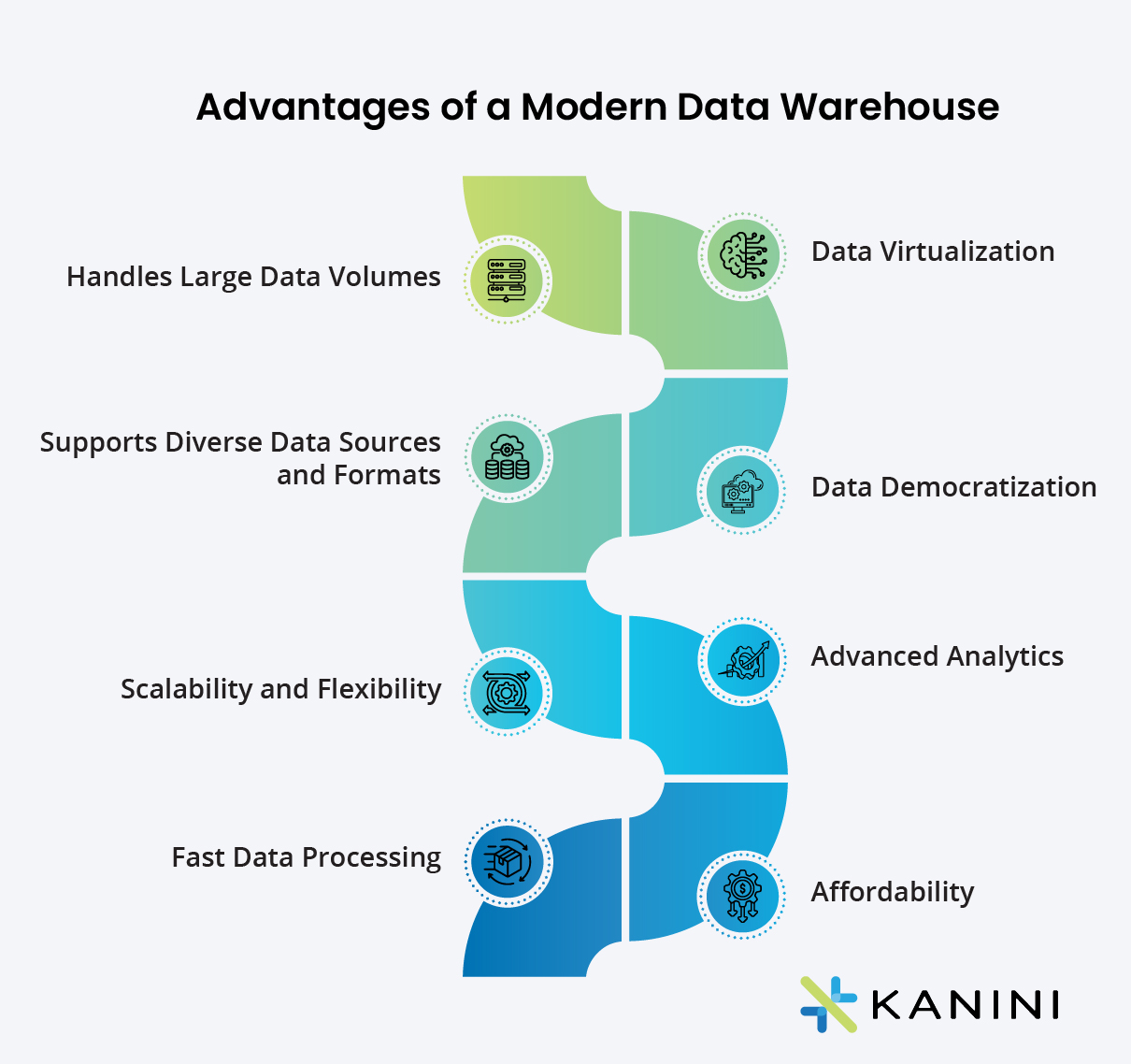Modern data warehouses have become a ready solution to the present-day data explosion, allowing businesses to leverage the best of conventional and contemporary tools for collecting, storing, and processing large volumes of data from diverse sources. New-age businesses have been increasingly turning to modern cloud-based data warehousing platforms to overcome the limitations of traditional data warehouses in harnessing the true potential of their data.
Modern data warehouses efficiently meet the scalability, flexibility, and analytical requirements of contemporary business enterprises and enable them to gain deeper insights through historical and real-time analysis of data. The modernization of the data warehousing infrastructure also empowers organizations to get a holistic view of their enterprise data to support global decision-making and drive their business intelligence (BI) and analytics initiatives collaboratively.
Table of Contents
Challenges with Traditional On-premises Data Warehouses
Back in the days when companies dealt with relatively small amounts of data on a daily basis, traditional setups and databases on-premises sufficiently met their operational needs. With time, the volume, variety, and velocity of data have increased significantly, making data warehouse modernization one of the core focus areas for CIOs, CTOs, CDOs, data engineers, data scientists, and other data professionals of enterprises. Some of the common challenges experienced by organizations using traditional data systems include the following:
- Traditional data warehouses that are built on-premises present scalability challenges and restrict business evolution.
- The high infrastructure management costs and expensive upgrades associated with on-premises data warehouses impact the overall modernization goals of a company.
- Data silos in traditional data warehouses limit cross-functional collaboration, critical for holistic decision-making.
- Data governance challenges pose data security and regulatory compliance risks, vital in the modern business environment.
- Meeting the demand for real-time data analysis becomes a struggle with traditional data systems, impacting decision-making for operational excellence, customer experience, and overall business growth.
Features and Benefits of a Modern Data Warehouse
Let’s explore some of the notable features of a modern data warehouse and how these support the data-driven business goals of today’s businesses.
- Handling Large Data Volumes
Using Extract, Load, and Transform (ELT) (rather than ETL used in a traditional data system), modern data warehouses can support larger amounts of data. This makes modern warehouses a popular option when data exceeds the capacity of traditional tools.
- Supporting Diverse Data Sources and Formats
Cloud infrastructure enables modern data warehouses to leverage data from diverse sources including social media feeds, IoT sensors, audio, and video. On the other hand, traditional data warehouses often source data only from conventional sources, such as operational or transactional databases. Also, modern data warehouses extend beyond the constraints of dealing solely with data of a uniform type or format, as in traditional data warehouses using relational databases.
- Scalability and Flexibility
The virtual instances in modern data warehouses are easier to scale and resize based on varying workloads. Easy-to-integrate modern data warehouses also offer the flexibility of leveraging the raw unstructured data stored in data lakes for a 3600 view of all data.
- Fast Data Processing
Modern data warehouses allow speedy ingestion and transformation of data. Leveraging advanced data replication tools, loading and transformation of large datasets can be completed within minutes. Proven performance optimization techniques, concurrency, and parallel processing aid in handling large data volumes efficiently.
- Data Virtualization
Seamless access to data, irrespective of its location or format, called data virtualization is what organizations need for global decision-making. Modern data warehouses offer self-service capabilities to various user types, eliminating data silos, data duplication, and other data-related challenges.
- Data Democratization
Data democratization refers to the idea of making data and its insights accessible to a wider audience within an organization, beyond just data specialists or IT professionals. Modern data warehouses contribute to data democratization in several ways. This helps create a more inclusive and data-driven organizational culture where insights from data are leveraged by a diverse set of stakeholders to drive business success.
- Advanced Analytics
A modern data warehouse’s capability of storing and analyzing enormous amounts of data allows companies to perform advanced predictive and preventive analytics and other cutting-edge analytics for critical insights. Modern data warehouses also support the sharing and analysis of IoT data streams for companies to gain deep insights into their operations.
- Affordability
As opposed to traditional data warehouses built on-premises that come with high maintenance costs and operational overheads, modern data warehouses are low-cost and low-maintenance. The cloud eliminates the need for expensive hardware and infrastructure. By adopting open-source technologies and commodity hardware, companies can build a cost-effective data system. Pay-as-you-go pricing models like usage-based billing and consumption-based billing make modern data warehouses more affordable.
Advantages of a Modern Data Warehouse

Building a Flexible Modern Data Warehouse Architecture
The features and flexibility of a modern data warehouse are intricately linked to its architecture. A well-designed and flexible architecture allows for efficient data processing, integration, and analysis, enabling the organization to derive true value from its data.
A big plus of a modern data warehouse is that it can adopt any architecture needed to address a particular challenge. A modern data warehouse can work perfectly using the Star Schema architecture, a characteristic of traditional data warehouses, and also it can leverage more specialized architectures.
Some examples of specialized architectures are Massively Parallel Processing (MPP), Lambda, and Hybrid.
- Massively Parallel Processing (MPP) Architecture: In the MPP architecture, also called the ‘’loosely coupled’’ or ‘’shared nothing’’ storage structure, multiple processors, each with its own operating system and memory, collaboratively perform a set of coordinated computations in a program. Speed and scalability are the two key advantages of a modern data warehouse employing an MPP architecture. The Snowflake Data Cloud for instance processes queries using MPP, offering the ease of use of a shared-disk architecture and performance benefits of a shared-nothing architecture.
- Lambda Architecture: The Lambda architecture featuring three layers – the speed or stream layer, the batch layer, and the serving layer – is common in big data applications. The speed layer supports real-time data processing for prompt insights. The batch layer handles raw data storage and processing of large volumes of historical data. The serving layer makes the results of the batch processing layer available for querying. While the Lambda architecture is complex, it offers several benefits such as it requires no management, is highly scalable, and allows businesses to react to situations in real-time.
- Hybrid Architecture: The hybrid architecture combines the best of both on-premises and cloud infrastructure for flexibility, scalability, governance, and optimization of various data processing and analytics tasks to meet specific business requirements.
Flexible architecture can help an organization be adaptive to evolving business requirements, handle diverse data sources, and scale to meet advanced analytical needs. Therefore, an organization needs to be careful in choosing its data warehouse architecture and ensure it aligns with the organization’s data estate.
Migrating to a Modern Data Warehouse: 5 Key Considerations
As modern data warehouses become an indispensable asset for businesses and open a wide range of opportunities, these opportunities also present associated challenges such as integration complexities, cost and performance optimization problems, and vendor lock-in limitations. These common roadblocks often deter companies from embracing data warehouse modernization. However, with a strategic approach to modernization, organizations can successfully overcome these challenges. Being mindful of the following pointers can help an enterprise transition from a traditional on-premises data warehouse to a modern data warehouse far more seamlessly and reap the long-term benefits of a modernized data infrastructure.
- 1. Aligning with Business Stakeholders
Engaging and collaborating with all the key stakeholders to prioritize data and analytics initiatives based on business priorities is the foundation for a successful migration.
- 2. Robust Metadata Management
Establishing a comprehensive metadata management strategy (ensuring that metadata includes information on data lineage, transformations, definitions, etc.) to track and document data throughout its lifecycle is important.
- 3. Choosing the Right Tools and Technologies
Every organization is different, each with unique challenges and capabilities. Therefore, evaluating and selecting modern data warehouse tools and technologies that best meet the organization’s requirements is important.
- 4. Implementing Data Governance Policies
To adapt to evolving regulatory requirements and industry standards, organizations must focus on developing a robust data governance framework.
- 5. Adapting to Changing Business Requirements
Implementing a flexible design and architecture, employing agile development and deployment methodologies and regularly reviewing and updating the data warehouse architecture is important to adapt to changing business requirements.
Today, an increasing number of organizations using traditional on-premises data systems such as Hadoop, Teradata, Informatica and Netezza are moving to more modernized and managed cloud-based big data solutions like Databricks, Snowflake, and Azure Synapse Analytics. With the right guidance, companies can overcome the migration challenges and make strategic choices in their data warehouse modernization journeys.
At KANINI, we enable enterprises spanning diverse industries including banking and financial services, healthcare, and manufacturing, to foresee the migration hurdles and prepare them for a seamless migration experience. We help enterprises build sophisticated data systems through a tailored approach that combines technical excellence with a deep understanding of unique business needs. Speak with our team to get the answers to your data-related challenges and evolve into a data-driven organization.
Author

Deepika Jayakodi
Deepika Jayakodi is a Data Architect at KANINI, bringing on board her decade-long expertise in Data Analytics, Warehousing, Business Intelligence, and Solutioning. She is an expert in project management, particularly in the US Healthcare, BFSI, and Manufacturing sectors. Deepika’s passion lies in architecting cloud data pipelines to deliver intelligent end-to-end solutions, demonstrating strategic implementation and analytical prowess.








